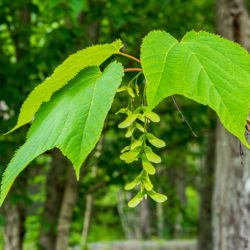Etymology
Acer is Latin for fierce, sharp, pungent, bitter, and pensylvanicum is derived from Latin referring to abundance of this species in the state of Pennsylvania; the lack of the traditional double “n” in pensylvanicum is attributed to a misspelling by Linnaeus.
Overview
Small, lovely, flowering native tree found in shady, cool, moist, acidic areas as a woodland understory. One of seven maple species found in New England, but easily identifiable by its unique striped bark (this is the only snake-bark or striped maple in North America, though there are 14 similar species in Asia). Rarely reaching maturity in the wild as it is heavily browsed.
Leaves and Stems
Trees are generally narrow, rounded or flat-topped, often multi-trunked (due to browse), with an open crown. Though trunks rarely exceed a diameter of 6 inches, in ideal conditions, they can grow to a height of 30 feet or more, and spread up to 20 ft. Bark is unique, smooth, and colorful, variously monotone red, green or black in young saplings, changing to green or grey as the tree ages and develops stripes (serpentine striations), which then fade again in the oldest trees. Stripes range from white to dark green or black, and are striking against the greenish bark. Leaves are the largest in the maple family, measuring approximately 7 inches across, long-stalked and palmately compound, each with 3 to 5 finely toothed lobes. Leaves range from pink in spring, through bright green in summer, to clear lemon yellow in autumn.
Flowers
Bright-yellow bell-shaped, often all-male flowers, approximately 1/3 inch in diameter, hanging from pendulous racemes up to 6 inches long. Flowers appear in spring once tree is near full leaf. Species demonstrates sexual dimorphism (sequential hermaphroditism), in that a single tree may change over its lifetime from bearing only male flowers, to bearing only female flowers in response to environmental changes.
Fruit/Seed
Fruits (samaras), which develop only on female trees, are 1 inch long and ripen in late summer or early autumn, appearing as chains of winged seeds, dangling among the large leaves.
Wildlife Associates
Common deer and moose browse. Bucks often scrape their antlers on the smooth bark, resulting in frequent long scars and tattered peeling bark on trunks. Other wildlife, including grouse and assorted rodents (rabbits, beaver), eat the seeds. Leaves sustain numerous butterfly larvae.
Propagation
Seed germination after 3-4 months cold stratification, or late softwood or semi-hardwood cuttings.
Garden Location
Performance Hall Garden (see garden map)
Sources
Ladybird Johnson Wildflower Project
Plant Profile by Kate O’Dell

